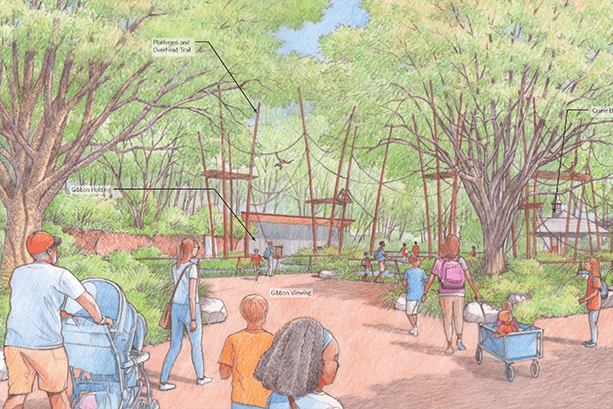The Giraffe House is currently only opened from 1:30 to 3 for Kipi and her calf, Titali.
A New Beginning
What does it take to re-imagine the nation’s third-oldest zoo? Last fall, the Maryland Zoo unveiled a strategic Master Plan that’s going to do just that.
Under the plan, the Zoo will generate guest and member excitement with a mix of new habitats, animal species, and upgrades to existing experiences. Its global work to save wildlife and wild places will be more visible than ever. Behind the scenes, the plan will lead to improved staff areas, event spaces, and community engagement.
“We’re bringing life to the front of the Zoo so our guests will encounter animals as soon as they walk through the gate,” said Zoo President & CEO, Kirby Fowler.
A new Gateway Building will hold a consolidated herpetology collection and spotlight the Zoo’s extensive conservation programs, like its work saving Panamanian golden frogs (Atelopus zeteki).


Leaving the building, guests will enter Main Valley, where they’ll encounter new habitats. “There hasn’t been a new animal experience in the oldest part of the Zoo for 18 years, so it’s time,” Fowler said.
“Gibbons (family Hylobatidae) were a past favorite. Imagine them here once again, on Gibbon Island, swinging through the trees and using their iconic call to communicate with their neighbors and guests,” Fowler said.
Plans also include a new Raptor Ridge for birds of prey to swoop down the hill below Mansion House.
The area around the former Elephant House will become Conservation Commons with guest amenities that include concessions at the Round Stand, seating, Embassy animal encounters, and event space.
The hill descending Main Valley will be re-graded and lined with new habitats that could feature wolverines and grizzly bears. At the bottom, there will be a new Chesapeake Flyway in the Maryland Wilderness section of the Zoo, and updated amenities in Zoo Central.
Thinking Strategically
The release of the Master Plan culminated a multi-year process to articulate a clear vision for the Zoo’s future, and to map exactly how to get there.
Stefansson Design & Consulting (SDC) was commissioned to shepherd the process. Over a span of almost two years, input was solicited from the Board of Trustees, staff, volunteers, and guests through surveys and multiple workshops.
“The process gave the Zoo community a structured way to think about who we are, how we operate, and how we want to evolve,” Fowler said. “Changing the entry experience emerged as the top priority.”
Other priorities will ensure that:
- Animal care will continue to be superior, with state-of-the-art veterinarian facilities, husbandry, and training. Animals will enjoy enhanced enrichment and control over their environments.
- The Zoo’s local and international conservation efforts will grow through more meaningful and holistic partnerships. The Zoo will achieve important sustainability milestones to reduce its environmental footprint. And it will work with the public to educate and engage people around conservation initiatives.
- Guests of all abilities will have equal access to educational programs, habitats, and amenities.
- Employees of all backgrounds will feel welcome at the Zoo, as part of an increasingly diverse workforce. They will receive constructive professional development and competitive compensation. Those who have worked in outdated trailers will relocate to a new office complex with modern amenities.
Funding
We haven’t wasted any time in launching the first phase of the Master Plan. Zoo staff is already raising public and private funds. Work on designing a new habitat for the North American porcupine (Erethizon dorsatum) is near completion, and major capital projects are set to begin.
With important financial support from the State of Maryland, the Zoo is kicking off reconstruction of its parking lots this spring. This project will replace impervious surfaces with a combination of functional parking spaces and a cutting-edge stormwater management system, which will improve the quality and control of the stormwater that flows into The Jones Falls.
Since 2008, the Zoo has a successful track record funding more than 70 projects of varying size, scope, duration, and complexity – thanks to the critical support of the State of Maryland, together with the City, adjacent counties, foundations, and private donors. This model will remain in place moving forward, and a test implementation schedule has been created to match project types with fundraising and marketing strategies.
Stay up to date on the Master Plan progress, animal news, and events by joining our mailing list.
 BACK TO STORIES
BACK TO STORIES
 MORE ZOOGRAM STORIES
MORE ZOOGRAM STORIES